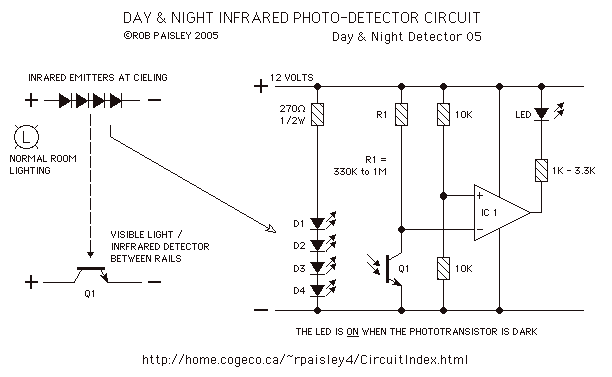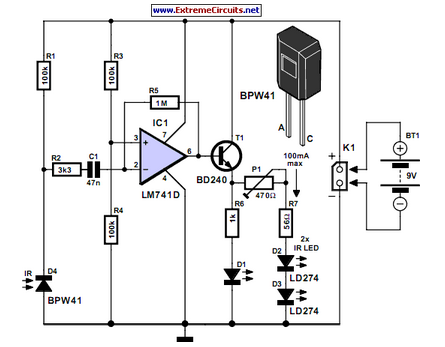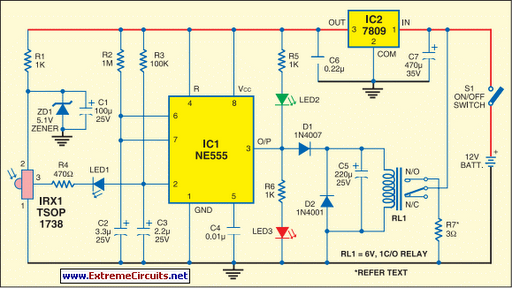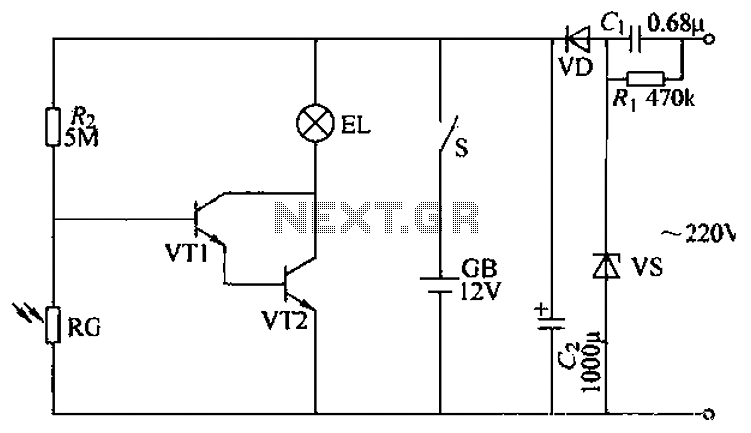
Day and Night Infrared Detection

The following is a method to allow day and night detection using Infrared/Visible light sensitive phototransistors and a simple LM339 voltage comparator circuit.
This circuit utilizes phototransistors that are sensitive to infrared and visible light to detect ambient light levels, thereby enabling the distinction between day and night. The LM339 voltage comparator is employed to compare the output voltage from the phototransistors against a predefined reference voltage, which is set to indicate the threshold between day and night conditions.
In this configuration, two phototransistors are arranged such that they can respond to the light intensity in the environment. The output from these phototransistors is connected to the non-inverting and inverting inputs of the LM339 comparator. The reference voltage can be established using a voltage divider formed by resistors connected to the power supply. This reference voltage is crucial as it determines the sensitivity of the circuit to light levels.
When the ambient light level exceeds the reference voltage during the day, the output of the comparator switches to a low state, indicating a "day" condition. Conversely, when the light levels drop below the reference voltage at night, the output switches to a high state, indicating "night." This output can then be used to trigger additional circuitry, such as lighting control systems or alarms.
The design can be further enhanced by incorporating hysteresis into the comparator circuit to prevent rapid switching between day and night states due to fluctuating light levels, such as those caused by passing clouds or shadows. This can be achieved by adding feedback from the output of the comparator back to the reference voltage through an additional resistor.
Overall, this method provides a reliable and efficient means of detecting day and night conditions using simple electronic components, making it suitable for various applications, including automated lighting systems, outdoor security lighting, and energy-saving devices.The following is a method to allow day and night detection using Infrared/Visible light sensitive phototransistors and a simple LM339 voltage comparator circuit. 🔗 External reference
This circuit utilizes phototransistors that are sensitive to infrared and visible light to detect ambient light levels, thereby enabling the distinction between day and night. The LM339 voltage comparator is employed to compare the output voltage from the phototransistors against a predefined reference voltage, which is set to indicate the threshold between day and night conditions.
In this configuration, two phototransistors are arranged such that they can respond to the light intensity in the environment. The output from these phototransistors is connected to the non-inverting and inverting inputs of the LM339 comparator. The reference voltage can be established using a voltage divider formed by resistors connected to the power supply. This reference voltage is crucial as it determines the sensitivity of the circuit to light levels.
When the ambient light level exceeds the reference voltage during the day, the output of the comparator switches to a low state, indicating a "day" condition. Conversely, when the light levels drop below the reference voltage at night, the output switches to a high state, indicating "night." This output can then be used to trigger additional circuitry, such as lighting control systems or alarms.
The design can be further enhanced by incorporating hysteresis into the comparator circuit to prevent rapid switching between day and night states due to fluctuating light levels, such as those caused by passing clouds or shadows. This can be achieved by adding feedback from the output of the comparator back to the reference voltage through an additional resistor.
Overall, this method provides a reliable and efficient means of detecting day and night conditions using simple electronic components, making it suitable for various applications, including automated lighting systems, outdoor security lighting, and energy-saving devices.The following is a method to allow day and night detection using Infrared/Visible light sensitive phototransistors and a simple LM339 voltage comparator circuit. 🔗 External reference





